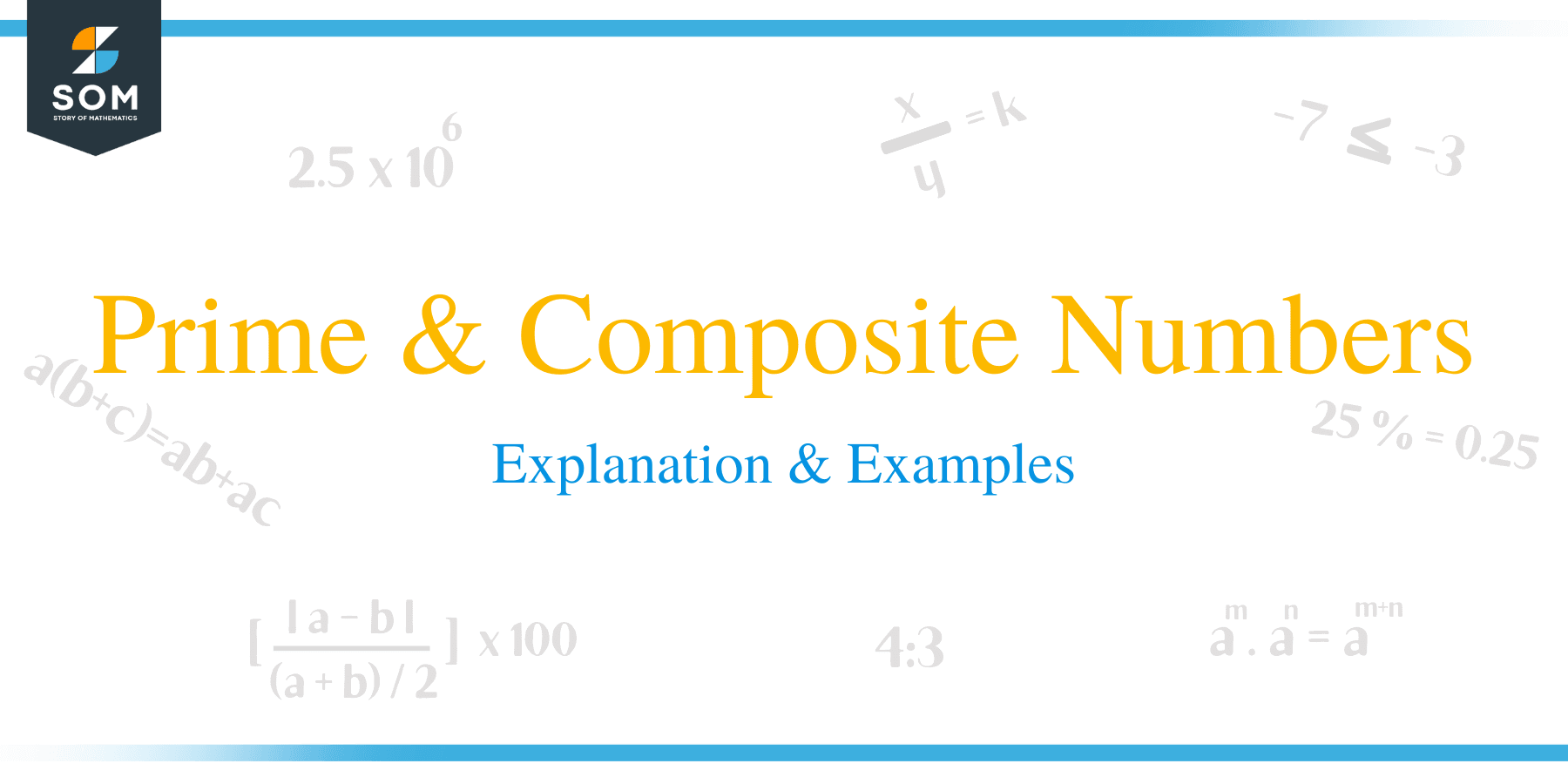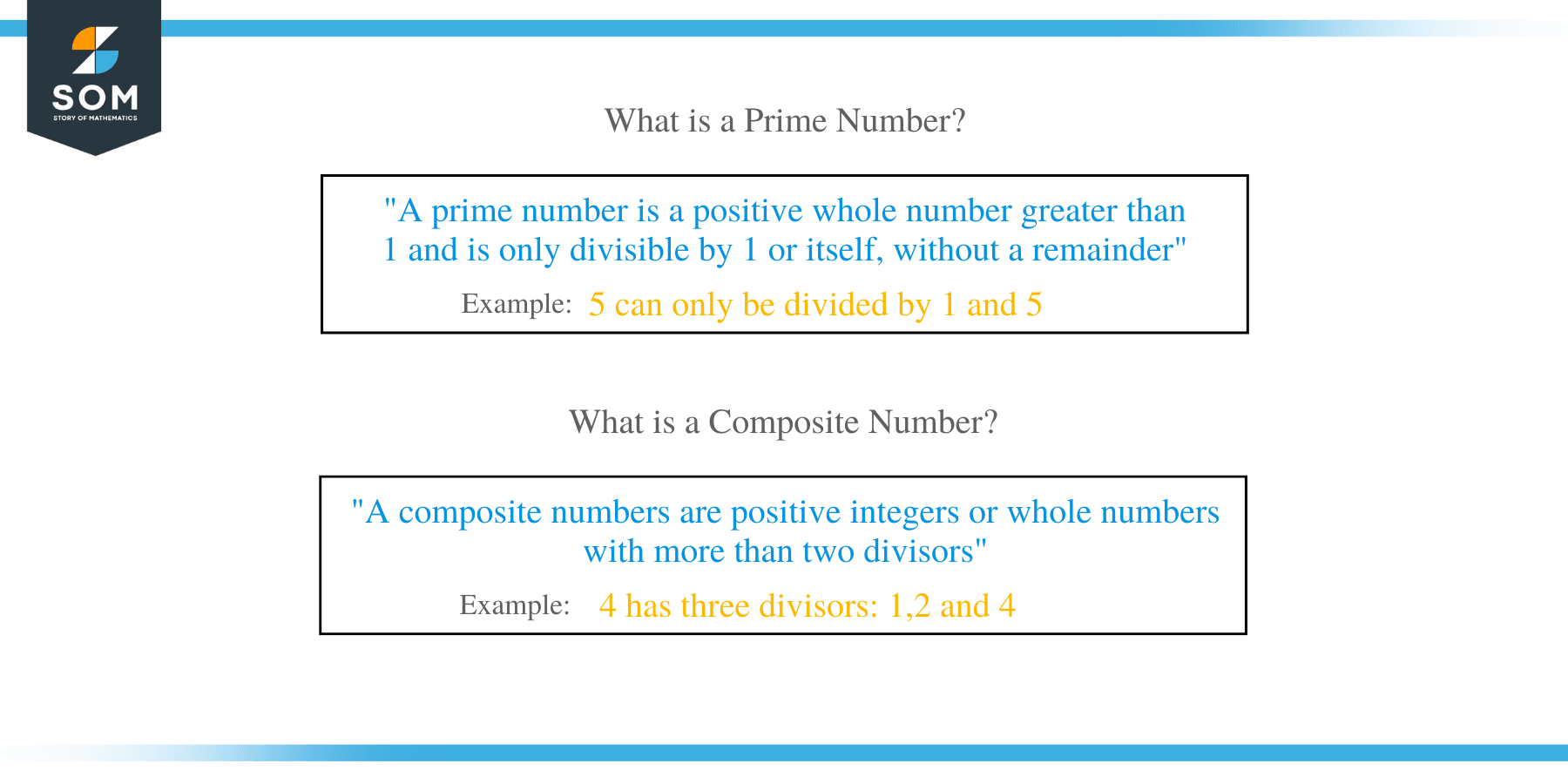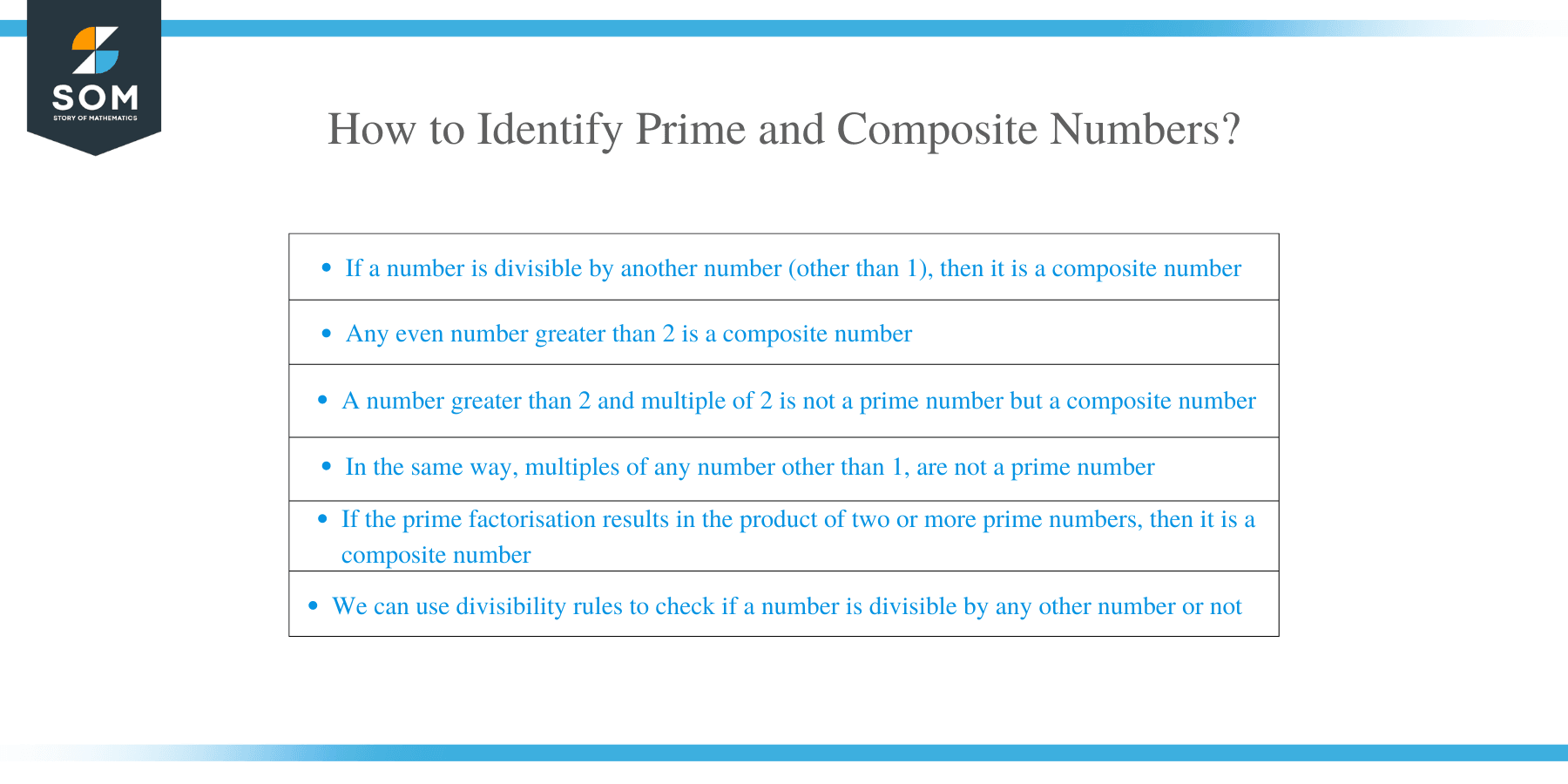- Home
- >
- Prime & Composite Numbers – Explanation with Examples
JUMP TO TOPIC
Prime & Composite Numbers – Explanation with Examples
 What is a Prime Number?
What is a Prime Number?
A prime number is a positive whole number greater than 1 and is only divisible by 1 or itself, without a remainder. In other words, a prime number is a positive integer that has two positive factors, including 1 and itself. For example, 5 can only be divided by 1 and 5.
Facts
- 2 is the only even prime number. All other even numbers are divisible by 2.
- All the prime numbers, except 2, are odd and called odd prime.
- No prime number beyond 5 has the last digit ending with a 5. All numbers greater than 5 which end with a 5 are divisible by 5.
- 0 and 1 are not prime numbers.
List of Prime Numbers
The following table shows all the prime numbers between 0 and 1000:
| 2 | 3 | 5 | 7 | 11 | 13 | 17 | 19 | 23 |
| 29 | 31 | 37 | 41 | 43 | 47 | 53 | 59 | 61 | 67 |
| 71 | 73 | 79 | 83 | 89 | 97 | 101 | 103 | 107 | 109 |
| 113 | 127 | 131 | 137 | 139 | 149 | 151 | 157 | 163 | 167 |
| 173 | 179 | 181 | 191 | 193 | 197 | 199 | 211 | 223 | 227 |
| 229 | 233 | 239 | 241 | 251 | 257 | 263 | 269 | 271 | 277 |
| 281 | 283 | 293 | 307 | 311 | 313 | 317 | 331 | 337 | 347 |
| 349 | 353 | 359 | 367 | 373 | 379 | 383 | 389 | 397 | 401 |
| 409 | 419 | 421 | 431 | 433 | 439 | 443 | 449 | 457 | 461 |
| 463 | 467 | 479 | 487 | 491 | 499 | 503 | 509 | 521 | 523 |
| 541 | 547 | 557 | 563 | 569 | 571 | 577 | 587 | 593 | 599 |
| 601 | 607 | 613 | 617 | 619 | 631 | 641 | 643 | 647 | 653 |
| 659 | 661 | 673 | 677 | 683 | 691 | 701 | 709 | 719 | 727 |
| 733 | 739 | 743 | 751 | 757 | 761 | 769 | 773 | 787 | 797 |
| 809 | 811 | 821 | 823 | 827 | 829 | 839 | 853 | 857 | 859 |
| 863 | 877 | 881 | 883 | 887 | 907 | 911 | 919 | 929 | 937 |
| 941 | 947 | 953 | 967 | 971 | 977 | 983 | 991 | 997 |
|
What is a Composite Number?
While prime numbers are numbers with two factors, composite numbers are positive integers or whole numbers with more than two divisors. For example, 23 has only two factors, 1 and 23 (1 × 23), and is, therefore, a prime number.
However, number 4 has three divisors: 1,2 and 4 (1 × 4 and 2 × 2).
List of Composite Numbers
Below is a list of all composite numbers up to 300.
4, 6, 8, 9, 10, 12, 14, 15, 16, 18, 20, 21, 22, 24, 25, 26, 27, 28, 30, 32, 33, 34, 35, 36, 38, 39, 40, 42, 44, 45, 46, 48, 49, 50, 51, 52, 54, 55, 56, 57, 58, 60, 62, 63, 64, 65, 66, 68, 69, 70, 72, 74, 75, 76, 77, 78, 80, 81, 82, 84, 85, 86, 87, 88, 90, 91, 92, 93, 94, 95, 96, 98, 99, 100, 102, 104, 105, 106, 108, 110, 111, 112, 114, 115, 116, 117, 118, 119, 120, 121, 122, 123, 124, 125, 126, 128, 129, 130, 132, 133, 134, 135, 136, 138, 140, 141, 142, 143, 144, 145, 146, 147, 148, 150, 152, 153, 154, 155, 156, 158, 159, 160, 161, 162, 164, 165, 166, 168, 169, 170, 171, 172, 174, 175, 176, 177, 178, 180, 182, 183, 184, 185, 186, 187, 188, 189, 190, 192, 194, 195, 196, 198, 200, 201, 202, 203, 204, 205, 206, 207, 208, 209, 210, 212, 213, 214, 215, 216, 217, 218, 219, 220, 221, 222, 224, 225, 226, 228, 230, 231, 232, 234, 235, 236, 237, 238, 240, 242, 243, 244, 245, 246, 247, 248, 249, 250, 252, 253, 254, 255, 256, 258, 259, 260, 261, 262, 264, 265, 266, 267, 268, 270, 272, 273, 274, 275, 276, 278, 279, 280, 282, 284, 285, 286, 287, 288, 289, 290, 291, 292, 294, 295, 296, 297, 298, 299, 300
How to Identify Prime and Composite Numbers?
To check if a number is prime or composite, the divisibility test of orders 2, 5, 3, 11, 7, and 13 is performed. A composite number is divisible by any of the above factors. A number less than number 121 is not divisible by 2, 3, 5, or 7 is prime. Otherwise, the number is composite. A number less than 289, which is not divisible by 2, 3, 5, 7, 11, or 13, is also prime. If not, the number is composite.
Example 1
Identify prime and composite numbers from the following list.
185, 253, 253, and 263.
Solution
Perform the divisibility test to identify composite and prime numbers.
263 is a prime number. 263 ends in an odd number 3, and therefore, it is not divisible by 2. Since its last digit is not 0 or 5, the number is also not divisible by 5. Lastly, the digital root of 263 is 2, i.e.
(2 + 6 + 3) = 11 and (1 + 1) = 2, so it is not divisible by 3.
Number 185 has the last digit as 5, so 185 is divisible by 5. In this case, the number is composite.
The number 253 has the last digit as 3, which is an odd number. Similarly, it doesn’t end in 0 or 5, 253 is not divisible by 5. The digital root of 253 is calculated as (2 + 5 + 3) = 10. (1 + 0) = 1, which isn’t divisible by 3. Therefore, 253 is a composite number.
The number 243 has the last digit as 3, so it is not divisible by 2. The number doesn’t have 0 or 5 as its last digit, and therefore, is not divisible by 5. Its digital root is obtained as (2 + 4 + 3) = 9, which is divisible by 3. Therefore, 243 is composite.
Example 2
Which of the following are composite or prime numbers?
3, 9, 11, and 14
Solution
The number 3 is a prime number because its factors are only 1 and 3. The number 9 is a composite number because its factors are 1, 3, and 9. The number 14 is a composite number because it is divisible by 1, 2, 7, and 14. The number 11 is also a prime number because it only has two factors: 1 and 11
Example 3
Identify prime and composite numbers from the following list:
73, 65, 172, and 111
Solution
Number 73 is a prime number. The last digit is not 0 or 5, and it is not a multiple of 7. The number 65 is a composite number because the last digit ends with 5 and is divisible by 5. The digital root of number 111 is 3, and so is divisible by 3. The number 111 is composite. The number 172 is also a composite because it is even, and therefore divisible by 2.
Example 4
Which of the following numbers is either prime or composite?
23, 91, 51, and 113
Solution
The number 23 is a prime because of the following cases: 23 is not an even number, its digital root is 5 and the number itself is not a multiple of 7. The digital root of 51 is 6 which is a multiple of 3. Number 51 is thus composite.
The number 91 is composite because the digital root is a multiple of 7. Number 113 is odd and does not end in 0 or 5. The digital root of 113 is not divisible by either 3 or 2. Number 113 is thus a prime.
Example 5
Differentiate between prime and composite numbers from the list below.
169, 143, 283, and 187
Solution
The number 143 is divisible by 11, and therefore, it is composite. The number 169 is also composite because it is divisible by 13. The number 187 is divisible by 11. In this case, the number is composite. The number 283 is prime because the last digit is not 5 or 0, and the digital root is 4, which is not divisible by 2, 3 or 5. It is also not a multiple of eleven, i.e. (+2 – 8 + 3) = 3.
